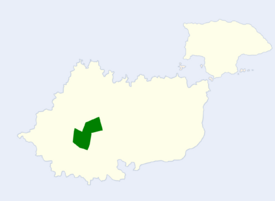Three Sisters Cloud Forest Preserve: Difference between revisions
mNo edit summary |
mNo edit summary |
||
| Line 16: | Line 16: | ||
| coordinates = | | coordinates = | ||
| coords_ref = | | coords_ref = | ||
| area = | | area = 21,130 ha (52,213 acres) | ||
| established = 1973 | | established = 1973 | ||
| visitation_num = | | visitation_num = | ||
| Line 24: | Line 24: | ||
| url = | | url = | ||
}} | }} | ||
The '''Three Sisters Cloud Forest Preserve''' is a [[Carucere|Carucerean]] reserve located in western [[Marien (island)|Marien]] within the [[New Sheaford Parish|New Sheaford]] and [[Côte Azure Parish|Côte Azure]] parishes. Founded in 1972 | The '''Three Sisters Cloud Forest Preserve''' is a [[Carucere|Carucerean]] reserve located in western [[Marien (island)|Marien]] within the [[New Sheaford Parish|New Sheaford]] and [[Côte Azure Parish|Côte Azure]] parishes. Founded in 1972 near the [[Three Sisters Mountains]], today the Reserve consists of over 21,130 ha (52,213 acres) of {{wp|cloud forest}}, of which 80% of which is virgin forest. It draws roughly 100,000 visitors a year, including many scientists. The reserve consists of three distinct biological zones with high {{wp|biomass}} and {{wp|biodiversity}}. The reserve is home over a thousand unique plant species and a couple hundred animal species such as the endemic {{wp|Imperial amazon|Sisserou parrot}}. | ||
==History== | ==History== | ||
Evidence shows that Nati tribes used the area around the Three Sisters for hunting and gathering for over a thousand years. After Euclean colonization, surviving Nati people fled into the mountains to escape; there they mixed with Bahian slaves to form the [[Caruceran Maroons]]. For the majority of the colonial period, the cloud forest was largely left intact as the logistics of maintaining a large-scale woodcutting operation was too difficult due to the steep terrain and the altitude. By the 1950s, the region was only affected by small logging operations by local foresters and small villages mostly populated by Maroons. | |||
Biologists began to take note of the Three Sisters in the 1960s. Despite the lack of infrastructure and shelter with which to conduct scientific research, they were interested in the unique habitat that was largely untouched. | |||
==Geography== | ==Geography== | ||
==History== | ==History== | ||
Revision as of 01:58, 31 January 2023
| Three Sisters Cloud Forest Preserve | |
|---|---|
| Réserve de la forêt de nuages des Trois Sœurs Twa Se Nwaj Forè Prezeve | |
 Three Sisters Forest Reserve | |
 Location of the Preserve in Carucere | |
| Location | New Sheaford Parish and Côte Azure Parish, Carucere |
| Nearest city | New Sheaford |
| Area | 21,130 ha (52,213 acres) |
| Established | 1973 |
The Three Sisters Cloud Forest Preserve is a Carucerean reserve located in western Marien within the New Sheaford and Côte Azure parishes. Founded in 1972 near the Three Sisters Mountains, today the Reserve consists of over 21,130 ha (52,213 acres) of cloud forest, of which 80% of which is virgin forest. It draws roughly 100,000 visitors a year, including many scientists. The reserve consists of three distinct biological zones with high biomass and biodiversity. The reserve is home over a thousand unique plant species and a couple hundred animal species such as the endemic Sisserou parrot.
History
Evidence shows that Nati tribes used the area around the Three Sisters for hunting and gathering for over a thousand years. After Euclean colonization, surviving Nati people fled into the mountains to escape; there they mixed with Bahian slaves to form the Caruceran Maroons. For the majority of the colonial period, the cloud forest was largely left intact as the logistics of maintaining a large-scale woodcutting operation was too difficult due to the steep terrain and the altitude. By the 1950s, the region was only affected by small logging operations by local foresters and small villages mostly populated by Maroons.
Biologists began to take note of the Three Sisters in the 1960s. Despite the lack of infrastructure and shelter with which to conduct scientific research, they were interested in the unique habitat that was largely untouched.